“Augmented IVR: Second Life for Interactive Voice Response”
By Dan Miller | June 24, 2014
 Featured Research
Featured Research
The ascent of the smartphone has propelled interactive voice response (IVR) technology well beyond the roles of simple call deflection or agent avoidance. IVRs are entering a new world of choice and customer empowerment. Far from forcing its last gasp, the smartphone has breathed new life into each enterprise’s IVR and voice app infrastructure, augmenting resources that bring both visual and voice resources into each customer’s critical path.
Featured Research Reports are available to registered users only.
For more information on becoming an Opus Research client, please contact Pete Headrick (pheadrick@cgy.bcc.myftpupload.com).
“Predictive Analytics: Using Big Data to Improve Multichannel Customer Care”
By Dan Miller | April 14, 2014
 Featured Research
Featured Research
Life is no longer lived “in real-time;” the future is already upon us. And the most admired companies and brands use Big Data and Predictive Analytics to get a head start. In this report, Opus Research analyzes the offerings of leading platform vendors who give companies the power to enable customers to use their device-of-choice and channel-of-choice at their time-of-choice.
Featured Research Reports are available to registered users only.
For more information on becoming an Opus Research client, please contact Pete Headrick (pheadrick@cgy.bcc.myftpupload.com).
“Opus Research Intelliview: Evaluating Enterprise Virtual Assistants”
By Dan Miller | January 23, 2014
 Overview
Overview
Intelligent Virtual Assistants are the go-to resource for customer care, tech support and marketing – becoming the basis for $700 million in investment by 2016. In this report, Opus Research evaluates the offerings of eight firms who have taken leadership in defining Intelligent Virtual Assistant for enterprise, customer care and self-service.
Featured Research Reports are available to registered users only.
For more information on becoming an Opus Research client, please contact Pete Headrick (pheadrick@cgy.bcc.myftpupload.com).
“The Case for Bimodal Authentication”
By Dan Miller | October 28, 2013
 Overview
Overview
Virtually every mobile phone, PC, tablet and laptop that has shipped in the past three years is equipped with a camera. As described in this report, voice security specialist SpeechPro offers a novel way to combine voice plus facial recognition to achieve very high levels of confidence when authenticating the identity of individuals carrying out personalized commerce, communications and collaboration.
Featured Research Reports are available to registered users only.
For more information on becoming an Opus Research client, please contact Pete Headrick (pheadrick@cgy.bcc.myftpupload.com).
“Strong Authentication for Mobile Commerce”
By Dan Miller | October 2, 2013
 Overview
Overview
The statistics surrounding mobile banking are impressive and growing dramatically. This year, more than 590 million phone users will have made use of their mobile devices for banking purposes, jumping to more than one billion individuals by 2017. Such accelerated activity is a magnet for fraudsters. Imposters use phone-based channels to perpetrate identity fraud, while thieves – using the tools that support mobile commerce – have more ways to commit “merchant fraud.” Voice biometrics proves to be an effective way to combat both.
Featured Research Reports are available to registered users only.
Click Here to View the Report Summary
For more information on becoming an Opus Research client, please contact Pete Headrick (pheadrick@cgy.bcc.myftpupload.com).
“The Conversational Cloud: Beyond the Hosted Contact Center”
By Dan Miller | September 16, 2013
 Overview
Overview
Blame Salesforce.com and Amazon Web Services for giving enterprises confidence in running mission-critical business processes and data in remote data centers. The ripple effect from the early migrations are permeating customer care and self-service strategies where solutions leverage Big Data, Predictive Analytics, Machine Learning and Natural Language Processing to foster simple, speedy task completion and customer empowerment.
Featured Research Reports are available to registered users only.
Click Here to View the Report Summary
For more information on becoming an Opus Research client, please contact Pete Headrick (pheadrick@cgy.bcc.myftpupload.com).
“Using Voice Biometrics for Strong Authentication and Risk Reduction”
By Dan Miller | July 29, 2013
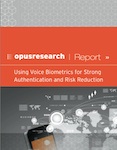 Overview
Overview
This era of self-service, cloud computing and Bring-Your-Own-Device (BYOD) has significantly accelerated the occurrence of fraudulent access, data breaches and identity theft. Hackers and fraudsters have more avenues of ingress to steal credentials and have their way with enterprise networks and data. Voice and multi-factor authentication offer an effective alternative to the prevailing, often ineffective methods and practices.
Featured Research Reports are available to registered users only.
Click Here to View the Report Summary
For more information on becoming an Opus Research client, please contact Pete Headrick (pheadrick@cgy.bcc.myftpupload.com).
Voice Biometrics Vendor Survey and “Intelliview” Mid-Year Edition (2013)
By Dan Miller | May 7, 2013
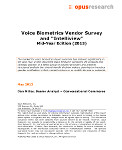
Overview
The market for voice biometrics-based solutions has matured significantly in the past year. In this document Opus Research compares the products and strategic position of a select group of solution providers and presents structured analysis that should benefit decision makers planning to introduce speaker verification in their contact centers or on mobile devices or networks.
Featured Research Reports are available to registered users only.
Click here to view the report summary
For more information on becoming an Opus Research client, please contact Pete Headrick (pheadrick@cgy.bcc.myftpupload.com).
Enterprise Readiness Series: The Case for Passive, Voice-Based Authentication
By Dan Miller | April 30, 2013
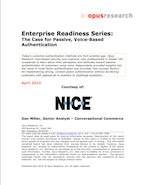
Overview
Today’s customer authentication methods are from another age. Opus Research interviewed security and customer care professionals in Global 100 companies to learn about their perception and attitudes toward passive authentication of customers using voice. Respondents provided insights into the value of multi-factor authentication and provided “key success factors” for implementing strong, context-aware authentication without burdening customers with passwords or answers to challenge questions.
Featured Research Reports are available to registered users only.
This report is made available courtesy of NICE Systems. Click here to view the report summary
For more information on becoming an Opus Research client, please contact Pete Headrick (pheadrick@cgy.bcc.myftpupload.com).
Research Report: 5 Rules for Survival in the BYOD Era
By Dan Miller | January 2, 2013
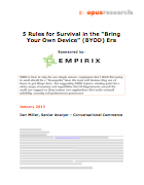
Overview
BYOD is here to stay for one simple reason: employees don’t think that going to work should be a “downgrade” from the tools and devices they use at home to get things done. But supporting BYOD is just a starting point for a whole range of services and capabilities that IT departments around the world can support as they nurture new applications that make network reliability, security and performance paramount.
Featured Research Reports are available to registered users only.
This report is made available courtesy of Empirix. Click Here to View the Report Summary
For more information on becoming an Opus Research client, please contact Pete Headrick (pheadrick@cgy.bcc.myftpupload.com).
Research Report: Personal Virtual Assistants: Primer and Planning Guide
By Dan Miller | November 29, 2012

Overview
We used to laugh at the idea of “the talking toaster” when thinking about the gratuitous addition of a speech-based interface to household appliances, consumer electronics, self-service kiosks or even ATMs. Now the machines laugh at us, as improvements in natural language understanding, artificial intelligence and text-to-speech rendering make phones, tablets, computers and (yes) household appliances more conversational, human-like and responsive to spoken input.
Featured Research Reports are available to registered users only.
Click Here to View the Report Summary
For more information on becoming an Opus Research client, please contact Pete Headrick (pheadrick@cgy.bcc.myftpupload.com).
Research Report – Voice Biometrics Vendor Survey and “IntelliView” 2012
By Dan Miller | October 29, 2012
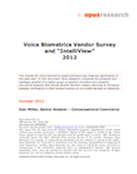
Overview
This document is the first map, or “IntelliView,” designed to display the relative strengths of selected voice biometrics technology providers based on their products, positioning and prospects for solving market requirements in the fast-evolving voice biometrics marketplace. For more than a decade, Opus Research has tracked the development efforts of a small community of companies as they defined the market for voice biometric-based products and services.
Featured Research Reports are available to registered users only.
Click Here to View the Report Summary
For more information on becoming an Opus Research client, please contact Pete Headrick (pheadrick@cgy.bcc.myftpupload.com).
Survey Results – Caller Authentication: Likes, Dislikes and Preferences
By Dan Miller | July 30, 2012
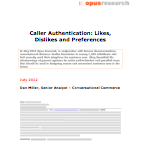
Overview
In May 2012 Opus Research, in conjunction with Nuance Communications, commissioned Coleman-Parkes Associates to survey 1,000 individuals who had recently used their telephone for customer care. They described the shortcomings of present systems for caller authentication and provided clues that should be used in designing secure and convenient customer care in the future.
Featured Research Reports are available to registered users only.
Click Here to View the Report Summary
For more information on becoming an Opus Research client, please contact Pete Headrick (pheadrick@cgy.bcc.myftpupload.com).
Conversational Commerce Paper: IVRs Take On New Tasks
By Dan Miller | June 14, 2012

Overview
People will go to great lengths to avoid interactive voice response (IVR) systems. Yet progressive, customer-pleasing companies like Hyatt Hotels are putting conversational IVR systems into place to the benefit of both their guests and their contact center agents. Therefore, in an age when some have said “The IVR is Dead,” we see “Conversational IVR” playing the role of Virtual Assistant in the enterprise, fostering a better customer experience and higher morale among customer service representatives.
This report made available courtesy of Interactions and Hyatt. Click Here to receive a copy.
Mobile Customer Care: New Paradigms and Practices
By Dan Miller | February 8, 2012
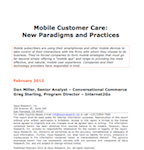
Overview
Mobile subscribers are using their smartphones and other mobile devices to take control of their interactions with the firms with whom they choose to do business. They’ve forced companies to form mobile strategies that must go far beyond simply offering a “mobile app” in order to provide the most effective, and natural, mobile user experience. Companies and their technology providers have responded in kind.
Featured Research Reports are available to registered users only.
For more information on becoming an Opus Research client, please contact Pete Headrick (pheadrick@cgy.bcc.myftpupload.com).
Click Here to View the Report Summary
Voice Biometric Authentication Best Practices: Overcoming Obstacles to Adoption
By Dan Miller | January 17, 2012
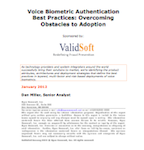
Overview
As technology providers and system integrators around the world successfully bring their solutions to market, we’re identifying the product attributes, architectures and deployment strategies that define the best practices in layered, multi-factor and risk-based deployments of voice biometrics.
This report made available courtesy of Validsoft. Contact Pete Headrick (pheadrick@cgy.bcc.myftpupload.com) to receive a copy
For more information on becoming an Opus Research client, please contact Pete Headrick (pheadrick@cgy.bcc.myftpupload.com).
Click Here to View the Report Summary
Enterprises in Denial: Dealing with the Personal Data Deluge
By Dan Miller | January 6, 2012

Overview
A remarkably high percentage number of C-level executives indicate their companies’ lack of a defined strategy to deal with all the “personal data” provided by customers and prospects through a multitude of channels. Yet they also tell us of their plans to incorporate that data into “understanding intent” and forging better communications links that promote loyalty, profitability and product refinement.
This report made available courtesy of Empirix. Contact Pete Headrick (pheadrick@cgy.bcc.myftpupload.com) to receive a copy
Click Here to View the Report Summary
Siri and the New Speech Imperative
By Greg Sterling | December 7, 2011
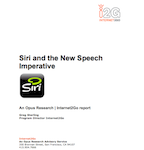
Overview
Siri is being covered in most of the business and popular press as a “mobile assistant.” But its long-term impact is tightly bound to how end-users discover, define, and get comfortable of new ways to control devices, navigate content and carry out daily activities through mobile devices.
Reports are available to registered users only.
For more information on becoming an Opus Research client, please contact Pete Headrick (pheadrick@cgy.bcc.myftpupload.com).
Voice in “The Cloud”: Catalyst for Conversational Commerce
By Dan Miller | August 23, 2011
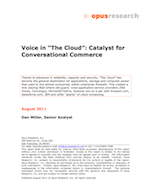
Overview
Thanks to advances in reliability, capacity and security, “The Cloud” has become the general destination for applications, storage and computer power that used to live almost exclusively within enterprise firewalls. This creates a new playing field where old-guard, voice application service providers (like Voxeo, Convergys, Microsoft/Tellme, Nuance) are on a par with Amazon.com, Salesforce.com, IBM and other “giants” of cloud computing.
Featured Research Reports are available to registered users only.
For more information on becoming an Opus Research client, please contact Pete Headrick (pheadrick@cgy.bcc.myftpupload.com).
Click Here to View the Report Summary
“The Social Contact Center: At the Hub of Conversational Commerce“
By Dan Miller | July 15, 2011
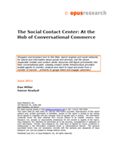
Overview
Shoppers and browsers turn to the Web, search engines and social networks for advice and information about goods and services; but the phone (especially mobile) and contact center resources still figure prominently into their conversational path. Leading contact center infrastructure providers enable agents to monitor, analyze and react to input and posts from a number of sources – primarily to gauge intent and engage customers.
Featured Research Reports are available to registered users only.
For more information on becoming an Opus Research client, please contact Pete Headrick (pheadrick@cgy.bcc.myftpupload.com).
Click Here to View the Report Summary
“Voice Biometrics Update 2011: Attacking Adjacent Markets“
By Dan Miller | May 2, 2011

Overview
With over 6.5 million registered voice prints supporting user authentication, we can begin to detect patterns that are defining successful adoption of the technology. It is clear that voice biometrics must be incorporated in multi-factor deployment schemes and that demand is destined to be driven by creating a positive user experience across multiple communications modalities and networks. That creates a “multiplier effect” as system integrators, application developers and mobile service providers discover the value of stronger authentication of individual end-users.
Featured Research Reports are available to registered users only.
For more information on becoming an Opus Research client, please contact Pete Headrick (pheadrick@cgy.bcc.myftpupload.com).
Click Here to View the Report Summary
“The Telco API Comes of Age: New Models For Voice and Telephony Mashups“
By Dan Miller | February 9, 2011

Overview
In January 2007, Opus Research’s annual “what to expect” advisory included a section called “Make Way for Mashups” in which we described opportunities to bring together content, information and status indicators from a variety of sources to deliver utility and novelty to phone users. We also said, “the most successful market participants are those that create revenue opportunities for their technology and marketing partners.” In this report, we revisit those observations and make more detailed observations surrounding what APIs and related resources serve the developer community well while building a multi-billion business.
Featured Research Reports are available to registered users only.
Click Here to View the Report Summary
“Gold Systems Leveraging a Long Legacy with Microsoft Lync“
By Dan Miller | May 26, 2010
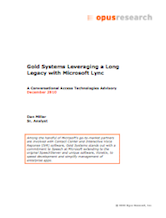
Overview
Among the handful of Microsoft’s go-to-market partners are involved with Contact Center and Interactive Voice Reponse (IVR) software, Gold Systems stands out with a commitment to Speech at Microsoft extending to the original SpeechServer and unique software, Vonetix, to speed development and simplify management of enterprise apps.
Advisories are available to registered users only.
“Survey Results: Companies “Unifying” the Conversational Contact Center“
By Dan Miller | November 17, 2010
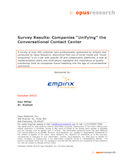
Overview
A survey of over 200 customer care professionals, sponsored by Empirix and conducted by Opus Research, discovered that use of social media and “cloud computing” is on a par with popular IM and collaboration platforms. A look at implementation plans and motivations highlights the importance of quality monitoring tools as companies travel headlong into the age of conversational commerce.
Featured Research Reports are available to registered users only.
Click Here to View the Report Summary
“Voice Application Hosting in the Era of Recombinant Communications”
By Dan Miller | June 29, 2010

Overview
Providers of hosted speech applications were ahead of the curve in anticipating and accommodating requirements for third-parties to handle seasonal or media-driven spikes in calls to customer care agents or IVR resources. Today, to stay ahead of the curve, leading hosted service providers pin their prospects for further success on the ability to accommodate a plethora of service delivery frameworks over multiple media as the notion of “X”-as-a-Service (where “X”=”Software,” “Platform,” “Applications,” etc.) takes hold.
Featured Research Reports are available to registered users only.

Leave a Reply